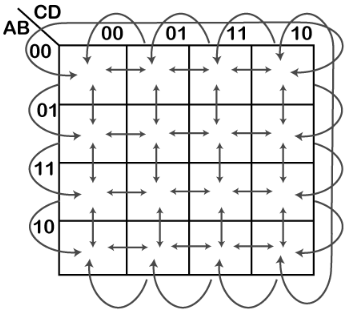K-map Method | Digital Circuits - Electronics and Communication Engineering (ECE) PDF Download
Karnaugh Map(K-Map) method
- The K-map is a systematic way of simplifying Boolean expressions. With the help of the K-map method, we can find the simplest POS and SOP expression, which is known as the minimum expression. The K-map provides a cookbook for simplification.
- Just like the truth table, a K-map contains all the possible values of input variables and their corresponding output values. However, in K-map, the values are stored in cells of the array. In each cell, a binary value of each input variable is stored.
- The K-map method is used for expressions containing 2, 3, 4, and 5 variables. For a higher number of variables, there is another method used for simplification called the Quine-McClusky method. In K-map, the number of cells is similar to the total number of variable input combinations. For example, if the number of variables is three, the number of cells is 23=8, and if the number of variables is four, the number of cells is 24. The K-map takes the SOP and POS forms. The K-map grid is filled using 0's and 1's. The K-map is solved by making groups. There are the following steps used to solve the expressions using K-map:
- First, we find the K-map as per the number of variables.
- Find the maxterm and minterm in the given expression.
- Fill cells of K-map for SOP with 1 respective to the minterms.
- Fill cells of the block for POS with 0 respective to the maxterm.
- Next, we create rectangular groups that contain total terms in the power of two like 2, 4, 8, … and try to cover as many elements as we can in one group.
- With the help of these groups, we find the product terms and sum them up for the SOP form.
2 Variable K-map
There is a total of 4 variables in a 2-variable K-map. There are two variables in the 2-variable K-map. The following figure shows the structure of the 2-variable K-map:
- In the above figure, there is only one possibility of grouping four adjacent minterms.
- The possible combinations of grouping 2 adjacent minterms are {(m0, m1), (m2, m3), (m0, m2) and (m1, m3)}.
3-variable K-map
The 3-variable K-map is represented as an array of eight cells. In this case, we used A, B, and C for the variable. We can use any letter for the names of the variables. The binary values of variables A and B are along the left side, and the values of C are across the top. The value of the given cell is the binary values of A and B at left side in the same row combined with the value of C at the top in the same column. For example, the cell in the upper left corner has a binary value of 000, and the cell in the lower right corner has a binary value of 101.
The 4-Variable Karnaugh Map
The 4-variable K-map is represented as an array of 16 cells. Binary values of A and B are along the left side, and the values of C and D are across the top. The value of the given cell is the binary values of A and B at left side in the same row combined with the binary values of C and D at the top in the same column. For example, the cell in the upper right corner has a binary value of 0010, and the cell in the lower right corner has a binary value of 1010.

5-variable K-map
With the help of the 32- cell K-map, the boolean expression with 5 variables can be simplified. For constructing a 5-variable K-map, we use two 4-variable K-maps. The cell adjacencies within each of the 4- variable maps for the 5-variable map are similar to the 4- variable map.A K-map for five variables (PQRST) can be constructed using two 4-variable maps. Each map contains 16 cells with all combinations of variables Q, R, S, and T. One map is for P = 0, and the other is for P = 1).
The document K-map Method | Digital Circuits - Electronics and Communication Engineering (ECE) is a part of the Electronics and Communication Engineering (ECE) Course Digital Circuits.
All you need of Electronics and Communication Engineering (ECE) at this link: Electronics and Communication Engineering (ECE)
|
75 videos|188 docs|70 tests
|
Related Searches
















